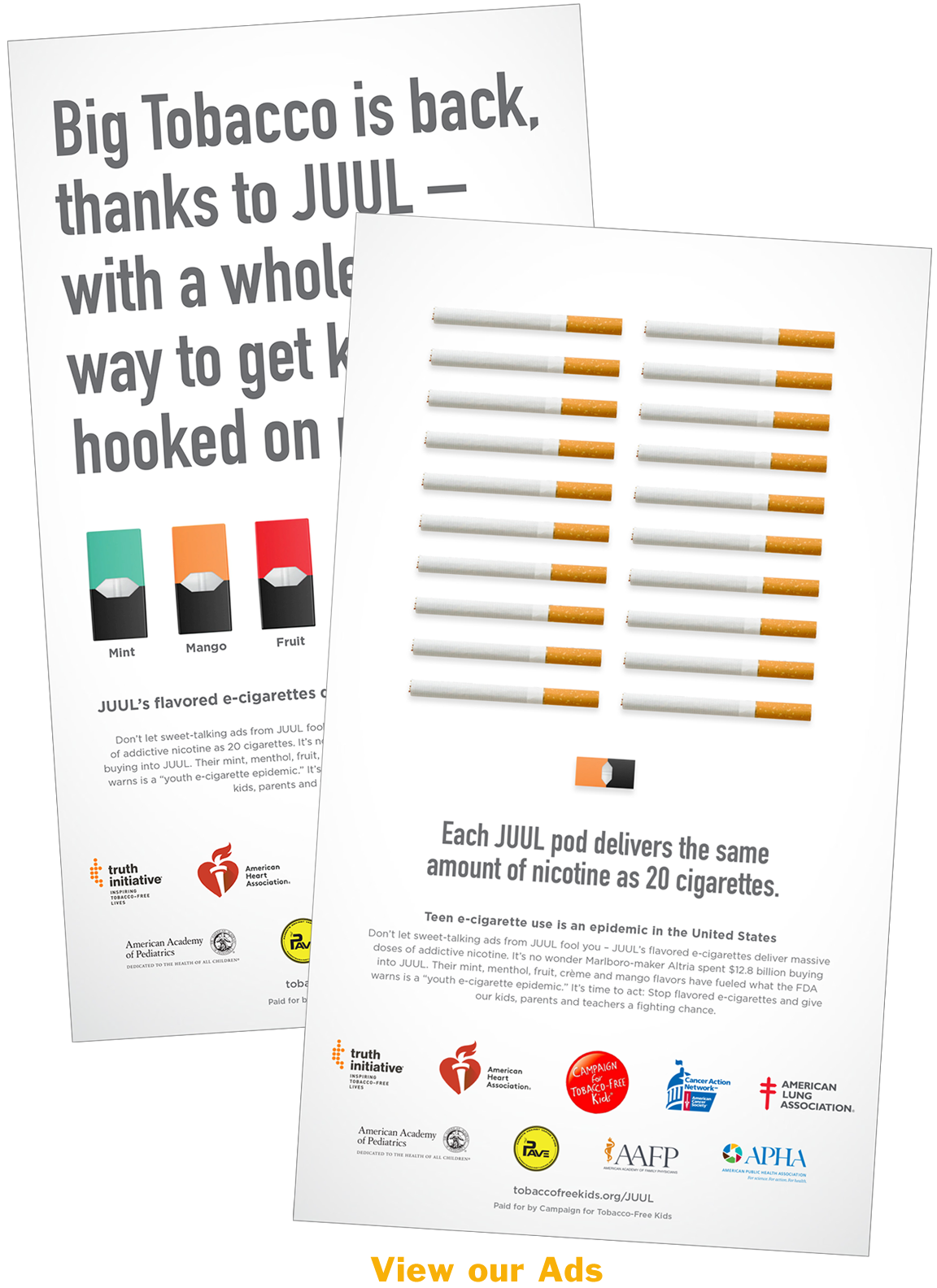Big Tobacco Is Back With
A New Way to Addict Kids:
Juul’s Flavored E-Cigarettes
Don’t let sweet-talking ads from Juul fool you – each Juul pod delivers the same amount of addictive nicotine as 20 cigarettes. It’s no wonder Marlboro-maker Altria spent $12.8 billion buying into Juul. Their mint, menthol, fruit, crème and mango flavors have fueled what the FDA warns is a “youth e-cigarette epidemic.”
It’s time to act: Stop flavored e-cigarettes and give our kids, parents and teachers a fighting chance.
Additional Information
- Youth e-cigarette use in the United States has skyrocketed to what the U.S. Surgeon General and the FDA have called “epidemic” levels
In 2018 alone, e-cigarette use among high school students rose by 78%, to 20.8% of students, according to the National Youth Tobacco Survey. Altogether, more than 3.6 million middle and high school students used e-cigarettes – an increase of 1.5 million in one year. E-cigarettes are addicting a new generation of kids and threaten to reverse decades of progress in reducing youth tobacco use. - The main cause of this epidemic is Juul, a sleek, high-tech e-cigarette that looks like a USB flash drive
Juul is small and easy to hide, comes in sweet flavors that entice kids and delivers a powerful nicotine hit. Educators and students report an alarming level of Juul use in middle and high schools across the country. Former FDA Commissioner Scott Gottlieb has stated, “There’s no question the Juul product drove a lot of the youth use.” - Juul is sold in flavors that appeal to youth, including mint, menthol, fruit, crème, mango and cucumber
Research shows that flavors play a key role in youth use of tobacco products, including e-cigarettes. Over 80% of kids who have used tobacco started with a flavored product, and 97% of current youth e-cigarette users have used a flavored e-cigarette in the past month. In addition to Juul, e-cigarettes are sold in over 15,000 flavors, including many flavors like cotton candy, gummy bear and cherry crush that clearly appeal to kids. - Juul delivers massive doses of nicotine, putting youth users at greater risk of addiction
The manufacturer has stated that each Juul “pod” (cartridge of nicotine) delivers as much nicotine as a pack of 20 cigarettes. However, research by Truth Initiative has found that many young Juul users don’t know the product always contains nicotine. - Juul’s popularity was fueled by the company’s social media marketing that featured attractive young people in fun, trendy settings
A report by Stanford University researchers concluded that Juul’s launch marketing was “patently youth oriented” and “subsequently Juul’s principal advertising themes have been closely aligned with that of traditional tobacco advertising.” - Juul’s success prompted Altria, maker of the best-selling Marlboro cigarette, to pay $12.8 billion for a 35% stake in Juul
The December 2018 deal brought together the companies that sell the most popular e-cigarette and cigarette brands among kids in Juul and Marlboro. - Juul and other e-cigarettes pose serious risks to the health of young people
A 2016 Surgeon General’s report concluded that youth use of nicotine in any form, including e-cigarettes, is unsafe, causes addiction and can harm adolescent brain development, which impacts attention, memory and learning. E-cigarettes can also expose users to harmful and carcinogenic chemicals such as formaldehyde and lead. - Studies have found that young people who use e-cigarettes are more likely to become smokers, and many are low-risk youth who would not have otherwise smoked cigarettes
A January 2018 report by the National Academies of Sciences, Engineering and Medicine concluded, “There is substantial evidence that e-cigarette use increases risk of ever using combustible tobacco cigarettes among youth and young adults.”
Strong Action Needed to Protect Kids
- The FDA regulates tobacco products, including e-cigarettes, but has yet to take effective action to protect kids and reverse the youth e-cigarette epidemic. It is especially critical that the FDA prohibit the flavored products that have fueled this epidemic.
- Because the FDA has failed to act, several bills have been introduced in Congress to crack down on flavored tobacco products. House Energy and Commerce Committee Chairman Frank Pallone (D-NJ) and Rep. Donna Shalala (D-FL) have introduced the Reversing the Youth Tobacco Epidemic Act of 2019, comprehensive legislation that includes a prohibition on flavored tobacco products. Sen. Dick Durbin (D-IL), Sen. Lisa Murkowski (R-AK), Rep. Diana DeGette (D-CO) and Jamie Raskin (D-MD) have introduced the Stopping Appealing Flavors in E-Cigarettes for Kids Act (SAFE Kids Act). Rep. Rosa DeLauro (D-CT) has also introduced legislation to stop tobacco companies from targeting kids with flavored products.
- Until the FDA acts, cities and states should continue their growing efforts to prohibit the sale of all flavored tobacco products. San Francisco in 2018 became the first city to do so, and other cities have since passed or are considering similar measures.









